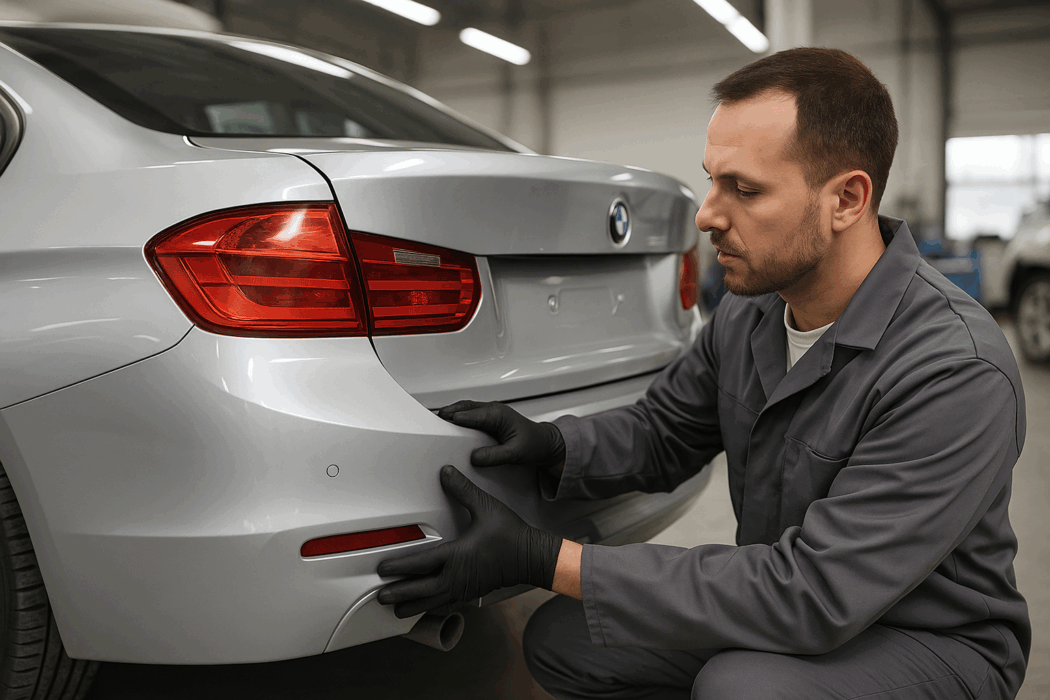You just picked up your brand-new car or had it freshly repaired, but something looks off. The bumper doesn’t quite match the rest of the car. It’s subtle, but once you notice it, you can’t unsee it.
Before you assume the shop made a mistake, here’s the truth: even new cars straight from the factory often have slight color variations between bumpers and body panels. Let’s break down why that happens and what you can do about it.
1. Different Materials, Different Reactions
Your car’s body panels are typically metal, while the bumpers are made from plastic or composite materials.
Even when the exact same paint formula is used:
-
Plastic and metal reflect light differently.
-
Paint absorbs and cures differently on each surface.
-
The texture beneath the paint affects how color appears.
These differences cause paint on bumpers to look slightly lighter or darker depending on lighting and angle. It’s not poor workmanship—it’s just physics and chemistry at play.
2. The Angle of Light Makes a Big Difference
Paint doesn’t look the same from every angle. The shape of the panel and how light refracts off the surface play a major role in how color appears.
That’s why colors like silver, gray, pearl white, and metallic blue tend to show mismatches more visibly.
Curved surfaces like bumpers reflect light in more directions, so even a perfect paint match on paper might look slightly different in daylight versus under shop lights.
3. Factory Variances Happen More Than You Think
It might surprise you, but factory paint jobs aren’t always identical across every part of the vehicle.
Automakers often paint bumpers and body panels in different facilities or with different processes:
-
The body panels are painted electrostatically with robotic precision.
-
Bumpers are usually painted separately, sometimes even by a third-party supplier.
-
Temperature, humidity, and spray techniques vary slightly from batch to batch.
Those small variances are why, even in showrooms, new vehicles can show subtle color shifts between plastic and metal components.
4. Aftermarket Paint Matching Challenges
When a bumper is replaced after an accident, the challenge grows.
Even with today’s digital color-matching systems, matching aged paint perfectly is nearly impossible because:
-
Paint fades and oxidizes over time.
-
UV exposure changes the hue of older panels.
-
Certain colors, especially reds, silvers, and pearls, are harder to match exactly.
To minimize visible differences, professional painters use a process called blending — gradually fading new paint into adjacent panels so the transition appears seamless. But that brings up the next point.
5. Why Insurance Companies Don’t Always Pay for Blending
Here’s something many drivers don’t realize:
Most insurance companies won’t pay to blend adjacent panels if only the bumper is being replaced.
That means:
-
The bumper is painted using your car’s factory color code.
-
Surrounding panels (like the fenders or quarter panels) are not blended unless you pay the difference.
Because older paint can fade slightly over time, skipping this blend may make the new bumper appear just a bit off.
At a registered Massachusetts auto body shop, you’ll always be informed of this upfront. Customers are given the option to approve blending work out of pocket to achieve a closer color match — but it’s important to know that insurance policies often cover only the direct area of damage.
6. Shops Can’t Guarantee a Perfect Match Without Blending — and Even Then There May Be a Slight Difference
Here’s the honest truth: no shop can guarantee a perfect color match without blending.
Even when blending is done, there may still be a very small variation — maybe not as noticeable as the factory difference, and sometimes almost perfect. But complete perfection is rarely achievable because of the different surfaces being painted.
Paint reacts differently on metal vs. plastic, and environmental factors (like humidity, paint thickness, or lighting) all play a role in how your eye perceives color.
A skilled painter can make it better, and sometimes nearly perfect, but never guaranteed. And when your insurance company won’t pay for blending, you’ll have to decide whether it’s worth paying out of pocket for something that still might show a slight difference.
If you didn’t notice the mismatch until the shop pointed it out, it’s worth asking yourself — does it really bother you that much?
Many vehicles roll out of the factory with similar variations, but most people never see them until they’re explained. Once you’re aware of it, the decision comes down to your comfort level and expectations.
7. How a Registered Shop Makes It Better
Choosing a registered and certified auto body shop in Massachusetts ensures your vehicle is refinished to the highest standards of safety and quality.
Here’s what a professional shop does to ensure the best possible result:
-
Use manufacturer-specific paint codes and digital color scanners.
-
Perform spray-out tests to fine-tune color before applying it.
-
Blend neighboring panels when possible to create a smooth transition.
-
Communicate clearly about expected results and limitations before any work begins.
Registered shops must follow state consumer protection laws, meaning your repair comes with accountability and transparency every step of the way.
Final Thoughts
Color differences between bumpers and body panels are common — even on brand-new vehicles. They’re not a sign of poor craftsmanship but rather the natural result of how paint interacts with different materials and lighting.
Blending can greatly improve the look, but even then, a perfect match isn’t always possible. What matters most is having a trusted, registered repair shop that communicates honestly, sets clear expectations, and delivers quality workmanship that restores your car’s safety, structure, and appearance.

